
|
|
The Pāratarājas are a little known dynasty who ruled in what is now the Pakistani province of Balochistan, probably during the second and third centuries.
This page summarizes about 10 years of research during which the names of these kings have finally been read correctly and a relative and absolute chronology
established. The research has been published in three separate papers. The first paper, which appeared in
Numismatic Chronicle, 2006, corrected and organized the silver Brahmi legend coins. The second paper,
Numismatic Chronicle, 2009, corrected and organized the Kharoshthi legend coins and also showed the relationships between the two series and suggested an
absolute chronology. The third paper, published in the Special Supplement to issue number 205 (Summer 2010)
of the Journal of the Oriental Numismatic Society, synthesized all the previous work and presented it as a unified whole. Most collectors have been using Senior's catalogues
of these coins. Senior's original catalogue was published in Volume 2 of his Catalogue of
Indo-Scythian Coins, and his up-dated catalogue, which adopted the results of my 2006 paper for the Brahmi legend coins, was published in his Addendum Volume 4. For
readers wanting to update their Senior catalogues, the following would be the corrections needed:
| ISCH Vol 3 | Corrected Name |
| Spajhana | Kozana |
| Spajhama | Koziya |
| Uncertain | Koziya |
| Bhimajhuna | Bhimarjuna |
| Miramara | Mirahvara |
| Ajuna | Arjuna |
In addition, the coin of the king named Vhunamtavhaspa? in the Volume 4 addendum was an issue of Datarvharna (see below). Contrary to the prevailing assumption
that the Brahmi legend coins must have followed the Kharoshthi legend coins, I have shown in the second paper that the chronology worked the other way. The coin catalogue
presented below lists the coins in their chronological order.
A poster on this coinage, prepared for the XV International Numismatic Convention in Taormina, Sicily (September 21-25, 2015)
can be seen here.
|
 |
Catalogue |
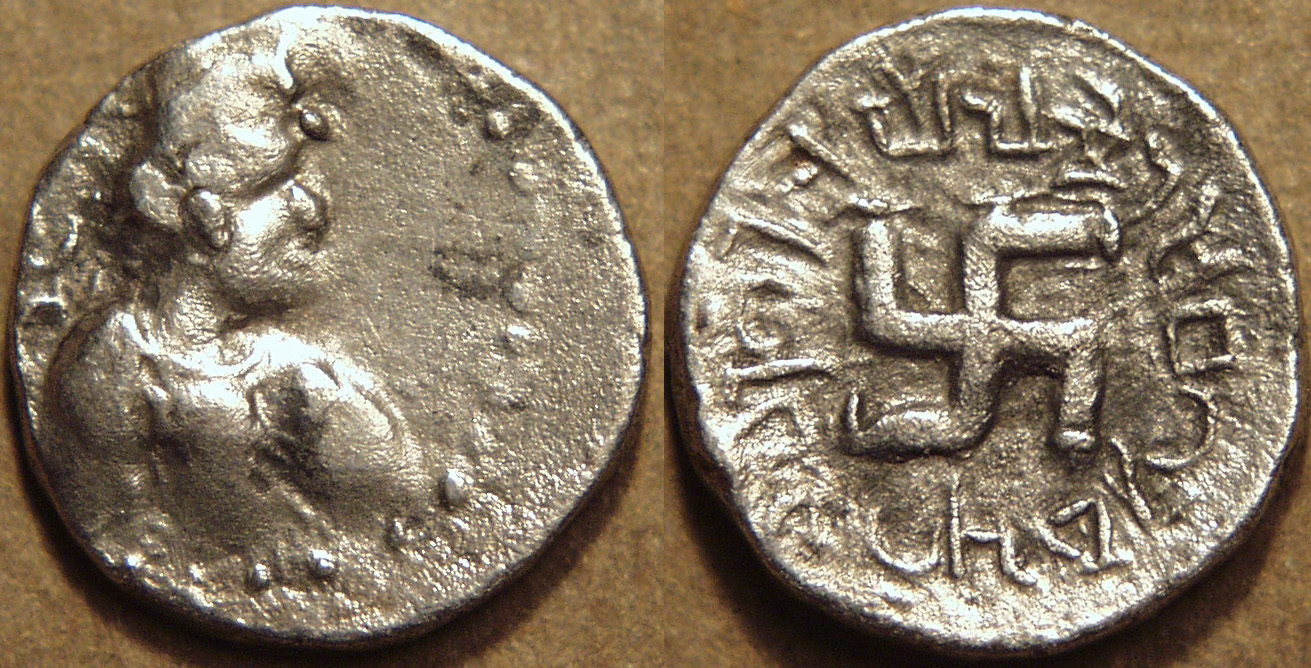
| Coin 1: Yolamira, silver drachm, early type
c. 125-150 CE
Weight:3.72 gm., Diam:16 mm.
Diademed bust right, dotted border /
Swastika right, Brahmi legend around:
(at 8h) Yolamirasa Bagarevaputasa Pāratarāja (ja retrograde)
(Of Yolamira, son of Bagareva, Pārata King) |
 |
The names Yolamira and Bagareva betray the Iranian origin of this dynasty. The suffix Mira refers to the Iranian deity Mithra. Yolamira means "Warrior Mithra." Bagareva means "rich God." (My thanks to Nicholas Sims-Williams for help in understanding the names of the kings.) |
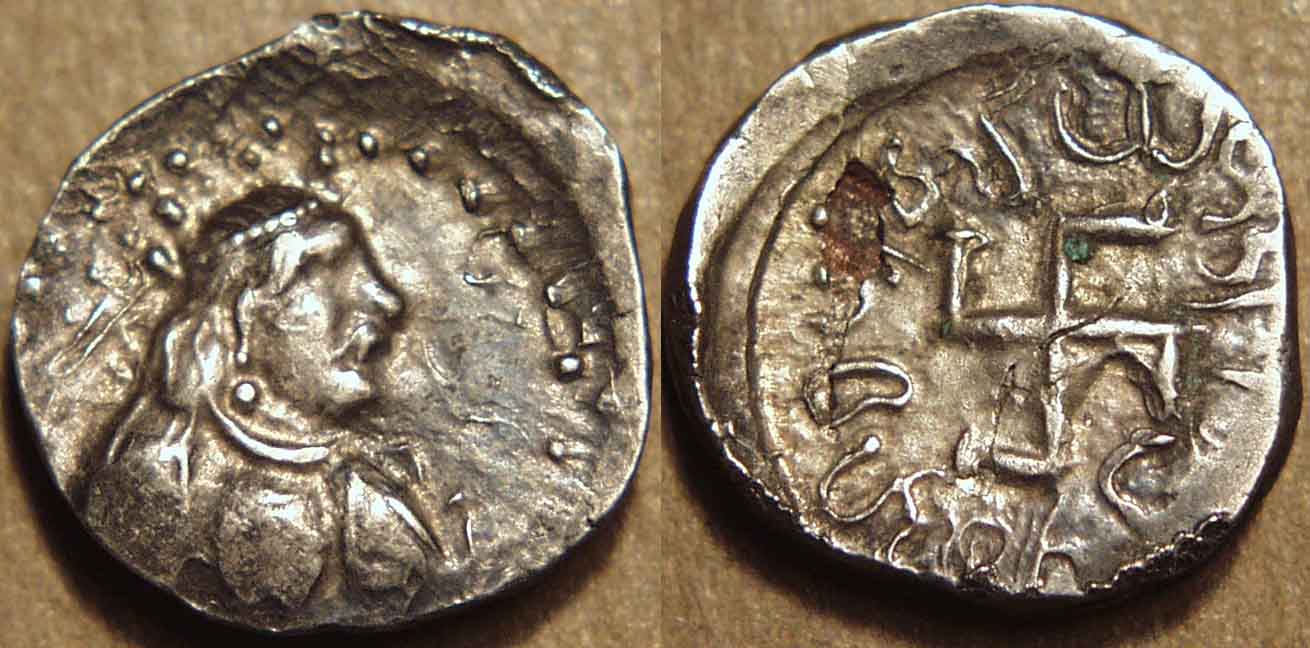
| Coin 2: Yolamira, silver drachm, late type
c. 125-150CE
Weight:3.91 gm., Diam:15-16 mm.
Diademed bust right, dotted border /
Swastika right, retrograde Brahmi legend around:
(at 7h) Yolamirasa Bagarevaputasa Pāratarājasa
(Of Yolamira, son of Bagareva, Pārata King) |
 |
We know this coin is from late in Yolamira's reign, because it shares a die with coins of his son Bagamira and Arjuna ... see the next two coins. |
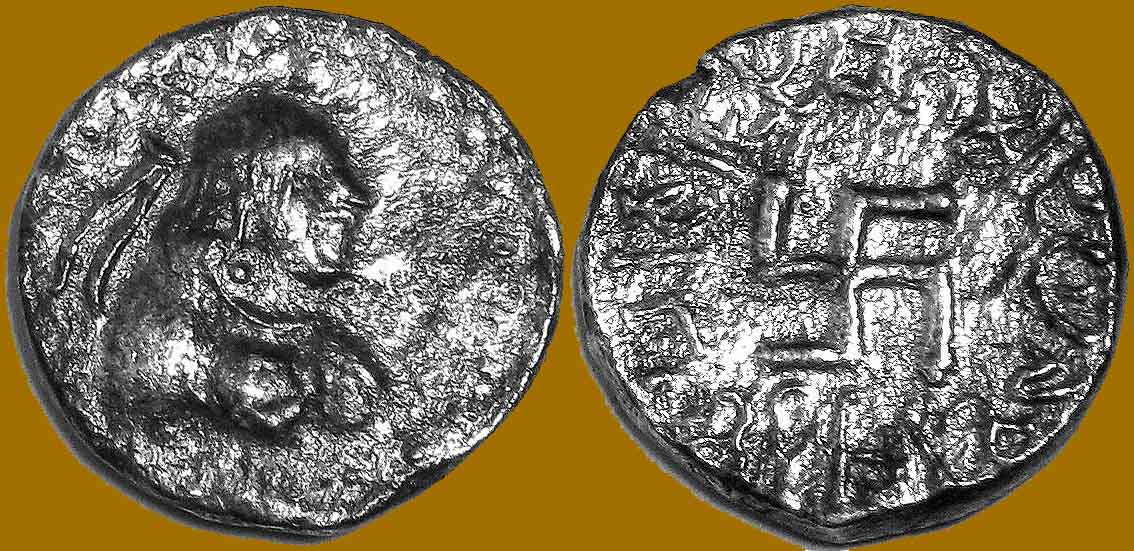
| Coin 3: Bagamira, silver drachm, late type
c. 150 CE
Weight:3.66 gm., Diam:15 mm.
Diademed bust right, dotted border /
Swastika right, Brahmi legend around:
(at 12h) Bagamirasa Yolamiraputrasa Pāratarājasa
(Of Bagamira, son of Yolamira, Pārata King) |
 |
Bagamira was probably Yolamira's oldest son, as he used his father's obverse die, which was then re-used by his younger brother Arjuna ... see the next coin. So Bagamira must have had a very short reign. This coin is so far the only one known of Bagamira ... photo courtesy Anne van't Haaff. |
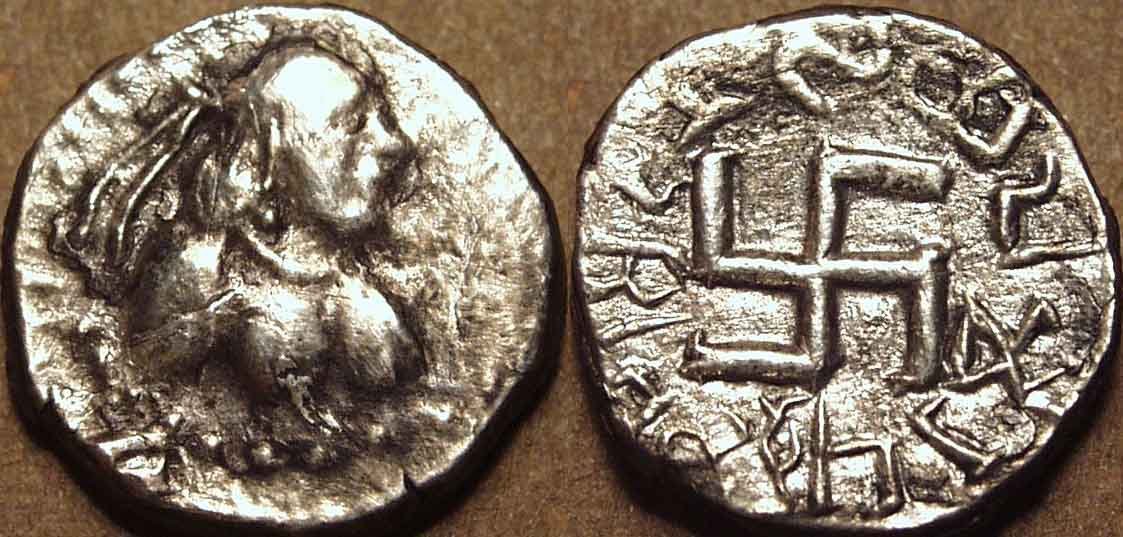
| Coin 4: Arjuna, silver drachm, early type
c. 150-165 CE
Weight:4.46 gm., Diam:16 mm.
Diademed bust right, dotted border /
Swastika right, Brahmi legend around:
(at 9h) Arjunasa Yolamiraputasa Pāra (sic! tarajasa missing)
(Of Arjuna, son of Yolamira, Pārata King |
 |
Thia coin shares an obverse die with coins 2 (Yolamira) and 3 (Bagamira). Since Arjuna issued coins with other dies, this must have been his early type and proves he followed Bagamira. |
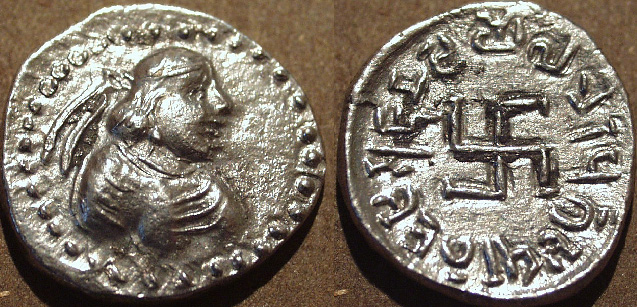
| Coin 5: Arjuna, silver drachm, late type
c. 150-165 CE
Weight:3.55 gm., Diam:17 mm.
Diademed bust right, dotted border /
Swastika right, Brahmi legend around:
(at 9h) Arjunasa Yolamiraputasa Pārata jasa (sic! ra missing)
(Of Arjuna, son of Yolamira, Pārata King |
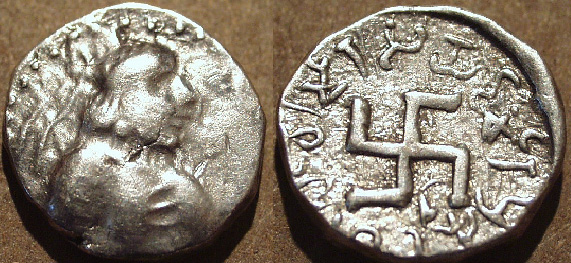
| Coin 6: Hvaramira, silver drachm, early type
c. 165-175 CE
Weight:3.39 gm., Diam:14 mm.
Diademed bust right, dotted border /
Swastika right, Brahmi legend around:
(at 9h) Hvaramirasa Yolamirasaputasa Pāratarāja (no sa)
(Of Hvaramira, son of Yolamira, Pārata King)) |
 |
Since this coin shares a die with the previous coin of Arjuna, who also issued coins that shared a die with Yolamira, we conclude that Hvaramira was Arjuna's younger brother, or at least that he ruled after him. No coins are known of any of Arjuna's sons. |
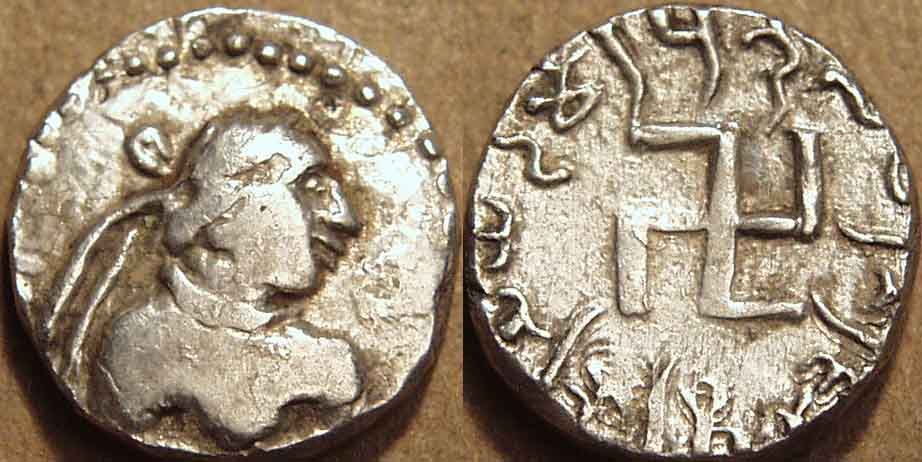
| Coin 7: Hvaramira, silver drachm, late type
c. 165-175 CE
Weight:3.64 gm., Diam:15-16 mm.
Diademed bust right, dotted border /
Swastika left, Brahmi legend around:
(at 6h) Hvaramirasa Yodamirasaputasa Pāratarājasa
(Of Hvaramira, son of Yolamira, Pārata King)) |
 |
Since this coin shares a die with the next coin of Hvaramira's son, we can infer that this was produced later in Hvaramira's reign. Note the left-turning swastika and the unusual spelling of Yolamira's name ... here spelled Yodamira. The word Yola means "war" in middle Persian, while "Yoda" begins to sound like "Yuddha" ... "war" in Sanskrit. |
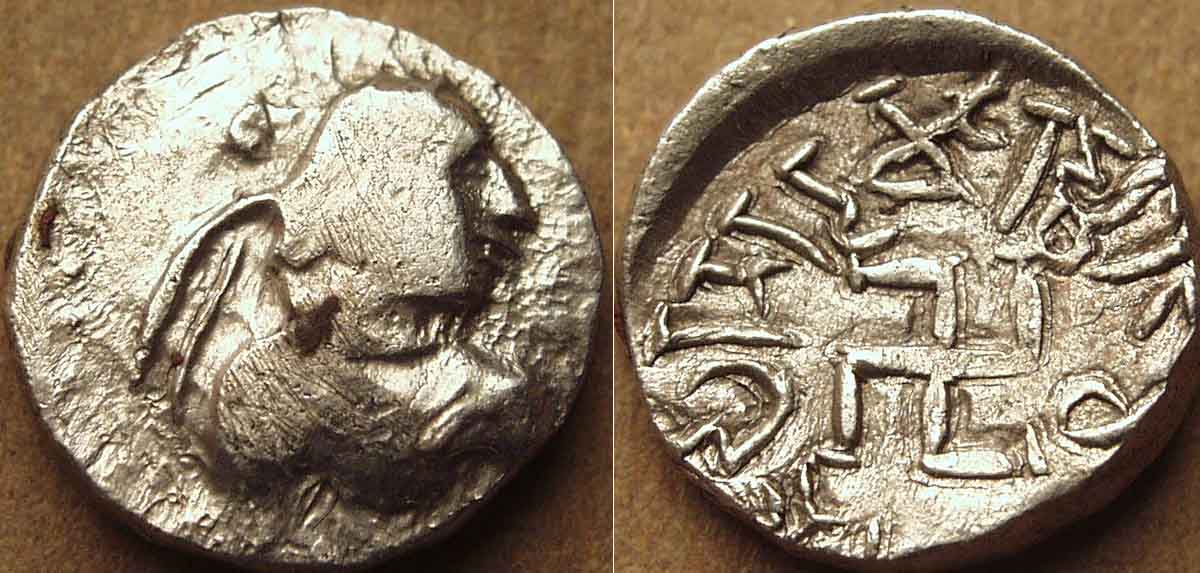
| Coin 8: Mirahvara, silver drachm, early type
c. 175-185 CE
Weight:3.57 gm., Diam:15 mm.
Diademed bust right, dotted border /
Swastika left, Brahmi legend around:
(at 12h) Mirahvarasa (H)va(ramiraputrasa) Pāratarāja (no sa)
(Of Mirahvara, son of Hvaramira, Pārata King) |
 |
In a now familiar pattern, the early coins of Mirahvara use the late dies of his father. Note the unusual letter forms on this coin. |
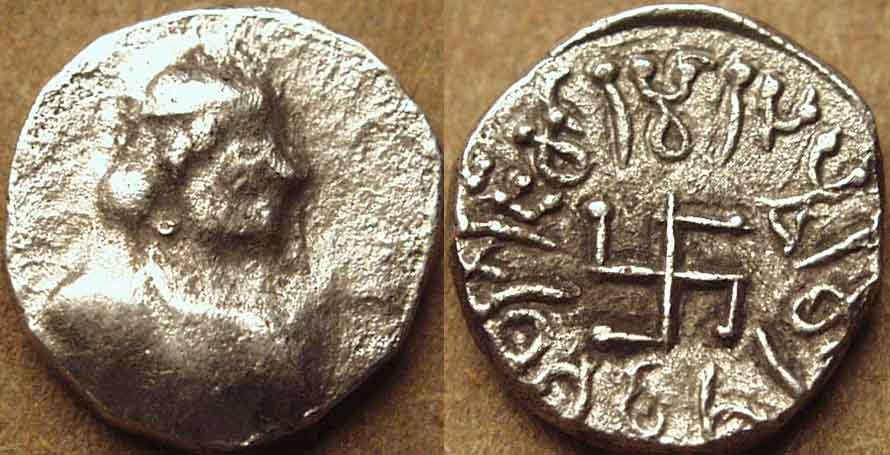
| Coin 9: Mirahvara, silver hemidrachm
c. 175-185 CE
Weight:1.65 gm., Diam:11-12 mm.
Diademed bust right, dotted border /
Swastika right, Brahmi legend around:
(at 11h) Mirahvarasa Hvaramiraputrasa Pāratarāja (no sa)
(Of Mirahvara, son of Hvaramira, Pārata King) |
 |
Mirahvara revived the issuance of hemidrachms like this one (no hemidrachm of Hvaramira is known), using an obverse die that had been used by Arjuna and even Yolamira! This coin features "older" letter-forms. |
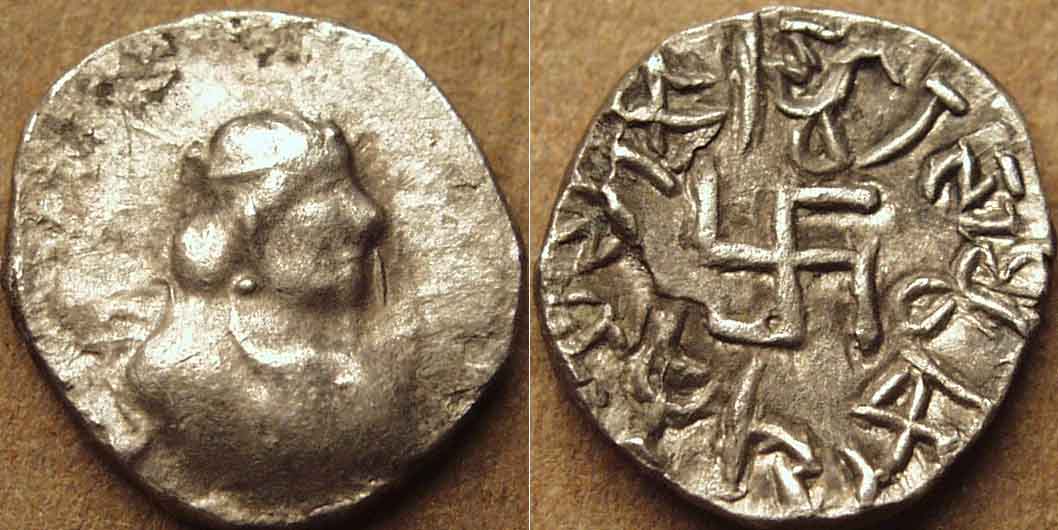
| Coin 10: Mirahvara, silver hemidrachm
c. 175-185 CE
Weight:1.80 gm., Diam:13-14 mm.
Diademed bust right, dotted border /
Swastika right, Brahmi legend around:
(at 11h) Mirahvarasa Hvaramiraputrasa Pāra (legend truncated)
(Of Mirahvara, son of Hvaramira, Pārata King) |
 |
A hemidrachm with the more unusual letter forms. |
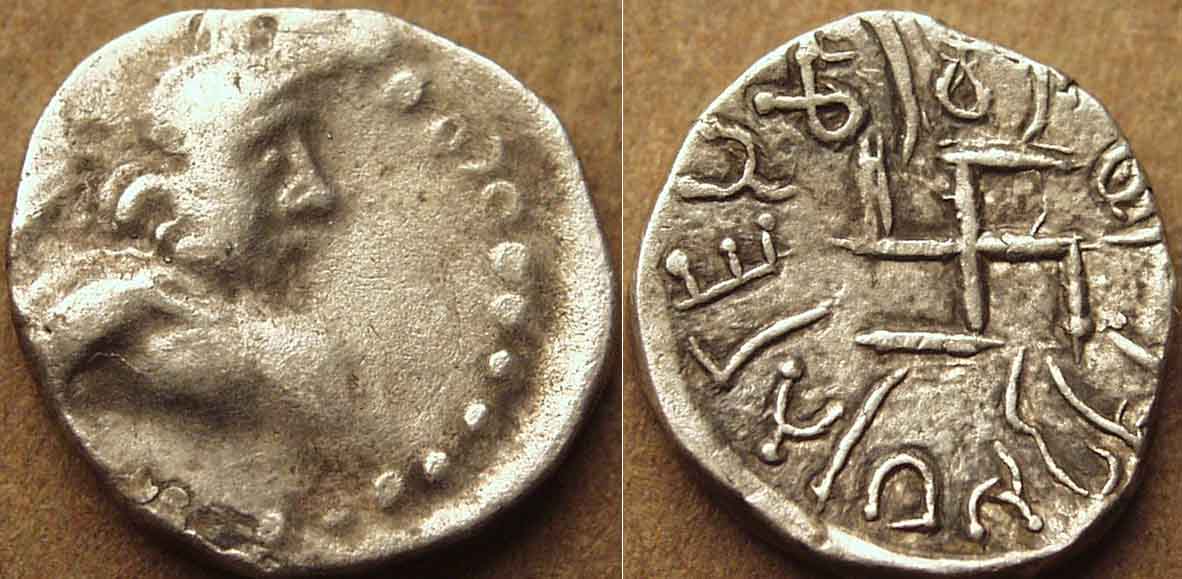
| Coin 11: Mirahvara, silver drachm, late type
c. 175-185 CE
Weight:3.08 gm., Diam:15-16 mm.
Diademed bust right, dotted border /
Swastika right, Brahmi legend around:
(at 10h) Mirahvarasa Hvaramiraputrasa Pāratarājasa
(Of Mirahvara, son of Hvaramira, Pārata King) |
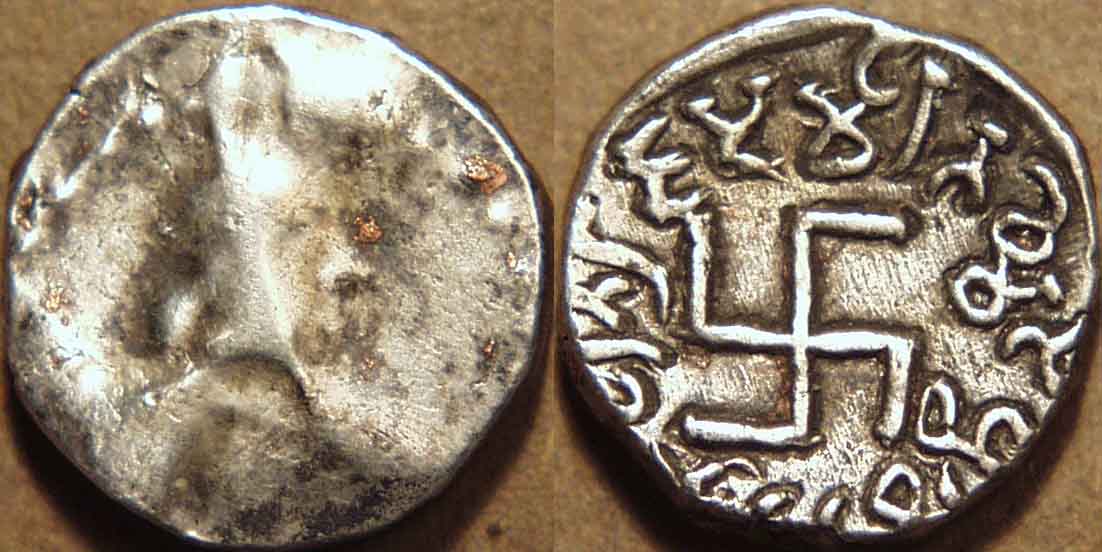
| Coin 12: Miratakhma, silver drachm, early type
c. 185-200 CE
Weight:3.39 gm., Diam:14 mm.
Diademed bust right, dotted border /
Swastika right, Brahmi legend around:
(at 12h) Miratakhmasa Hvaramiraputrasa Pāratarājasa
(Of Miratakhma, son of Hvaramira, Pārata King) |
 |
Although this coin's obverse die was badly cracked, it is clearly identifiable as the same die that was used to produce coin 11 of Mirahvara ... there are coins of Mirahvara that show the same deep die crack. Miratakhma appears to have been the younger brother of Mirahvara, since he shares a die only with his brother and not with his father. |
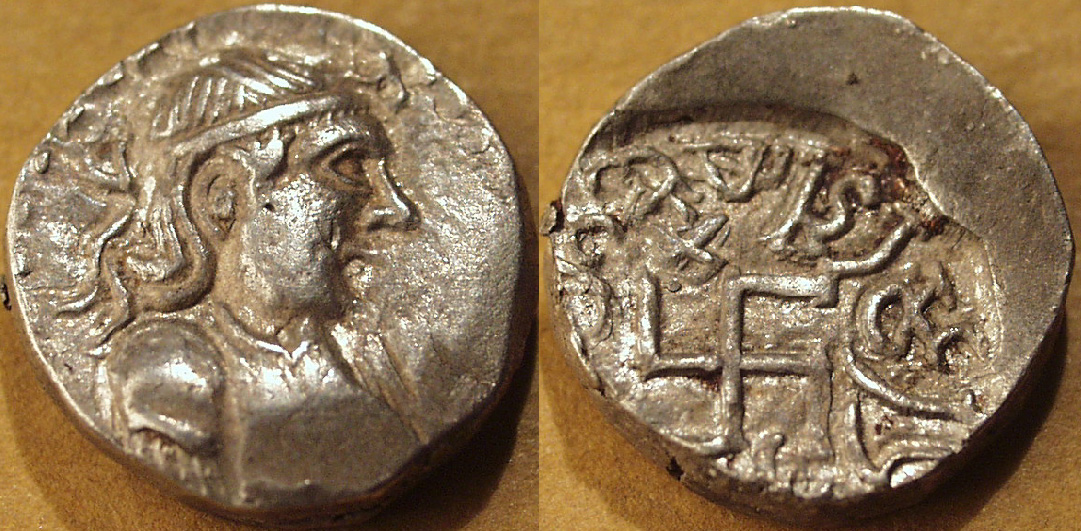
| Coin 13: Miratakhma, silver drachm
c. 185-200 CE
Weight:3.30 gm., Diam:15 mm.
Diademed bust right, dotted border /
Swastika right, Brahmi legend around:
(at 9h) (Mi)ratakhmasa Hvaramirapu(trasa Pāratarāja)
(Of Miratakhma, son of Hvaramira, Pārata King) |
 |
The letter forms on this coin are most unusual, particularly the compound letter khma. It also has a quite unusual portrait style. |
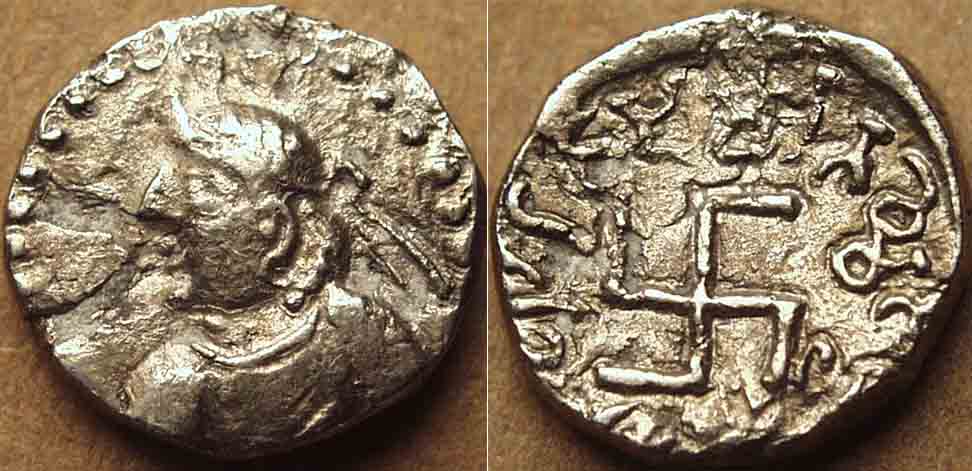
| Coin 14: Miratakhma, silver drachm, late type
c. 185-200 CE
Weight:3.55 gm., Diam:15 mm.
Diademed, crowned bust left, dotted border /
Swastika right, Brahmi legend around:
(at 12h) Miratakhmasa (Hvaramiraputrasa) Pāratarāja
(Of Miratakhma, son of Hvaramira, Pārata King) |
 |
This coin has a couple of innovations that mark it as coming from late in Miratakhma's reign: it is the first Pāratarāja coin to have the king's bust facing left, and it is also the first coin to show the king wearing a crown ... a peaked tiara. |
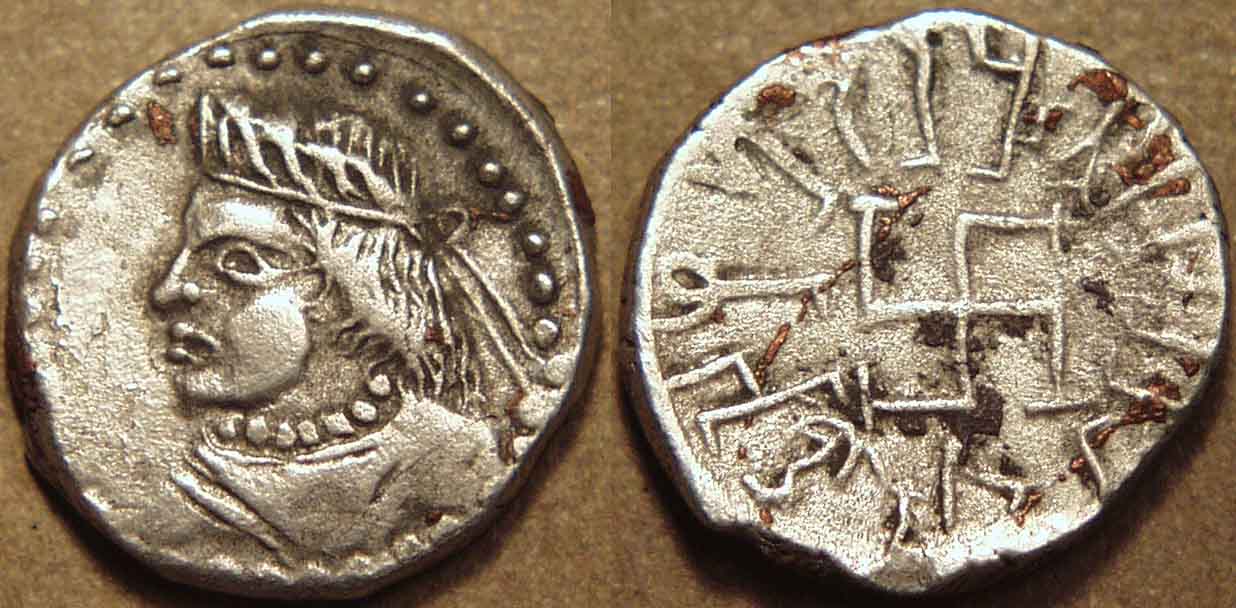
| Coin 15: Kozana, silver drachm (reduced weight standard)
c. 200-225 CE
Weight: 2.23 gm., Diam:15 mm.
Diademed, crowned bust left, dotted border /
Swastika right, Kharoshthi legend around:
(at 11h, counterclockwise) Kozanasa Bagavharnaputrasa Pāratarājasa
(Of Kozana son of Bagavharna, Pārata King) |
 |
Kozana was the first Pāratarāja king to issue coins with the legends in Kharoshthi, like on this coin. Most authors had presumed that the Kharoshthi legend coins must have come before the Brahmi legend coins, as it was Brahmi that replaced Kharoshthi everywhere else in India. But it can be shown that Kozana's coins came after the Brahmi legend coins. His are the only Kharoshthi legend coins in silver and he follows the style of Miratakhma's late coins, with the bust left and the tiara crown (seen even better on the next coin). For more, see my 2009 paper. |
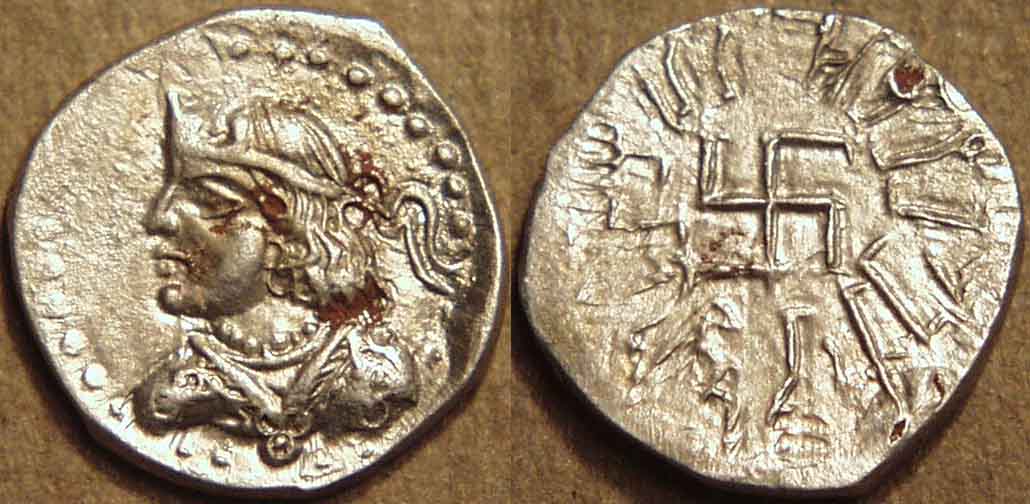
| Coin 16: Kozana, silver hemidrachm (reduced weight standard)
c. 200-225 CE
Weight: 1.04 gm., Diam:12-13 mm.
Diademed, crowned bust left, dotted border /
Swastika right, Kharoshthi legend around:
(at 10h, counterclockwise) Kozanasa Bagavharnaputrasa Pāratarājasa
(Of Kozana son of Bagavharna, Pārata King) |
 |
This coin shows the peaked tiara, initiated by Miratakhma, very clearly. No one knows for sure who was Kozana's father Bagavharna (pronounced Bagafarna) was, but I have suggested in my 2009 paper that he was Bagamira's son. |
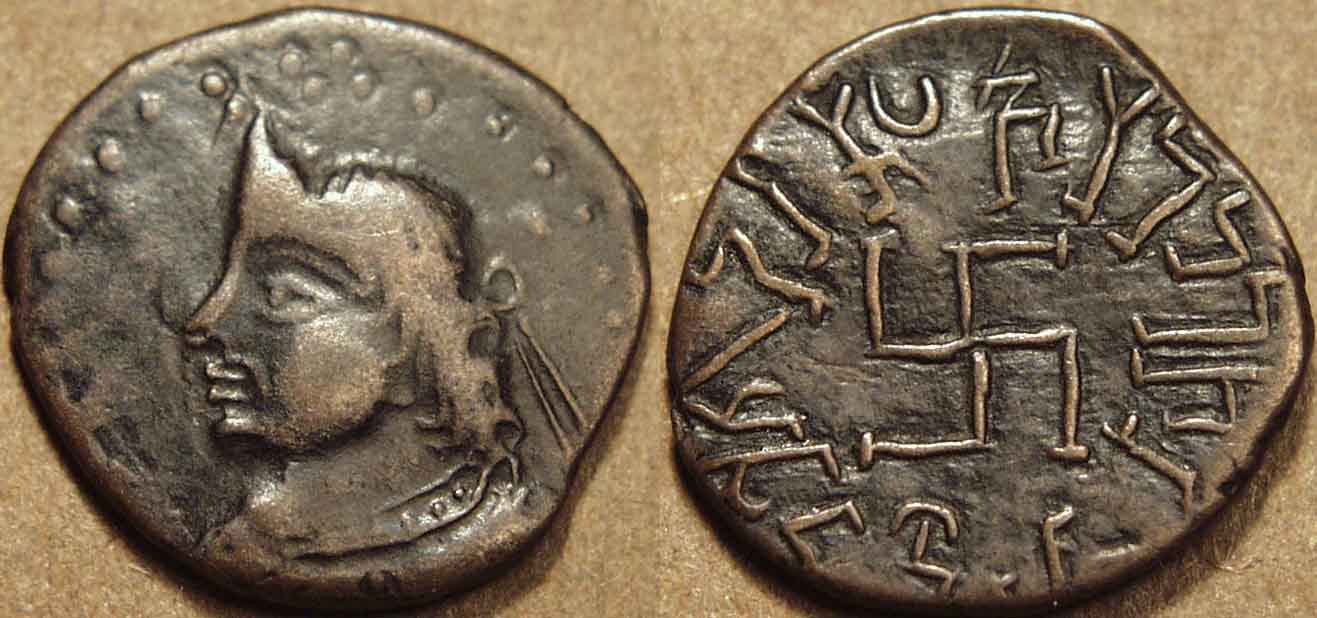
| Coin 17: Bhimarjuna, billon drachm (reduced weight standard)
c. 225-235 CE
Weight: 2.09 gm., Diam:15-16 mm.
Diademed, crowned bust left, dotted border /
Swastika right, Kharoshthi legend around:
(at 12h, counterclockwise) Bhimarjunasa Yolatakhmaputrasa Pāratarāja (no sa)
(Of Bhimarjuna son of Yolatakhma, Pārata King) |
 |
With Bhimarjuna, the debasement of the Pārata currency starts. Some early coins show more silver than this one; later coins seem to be almost pure copper. The fact that Bhimarjuna's coinage shows the gradual debasement proves that he followed Kozana. Although we do not know who was Bhimarjuna's father, Yolatakhma, I have argued that he must have been Arjuna's son. |
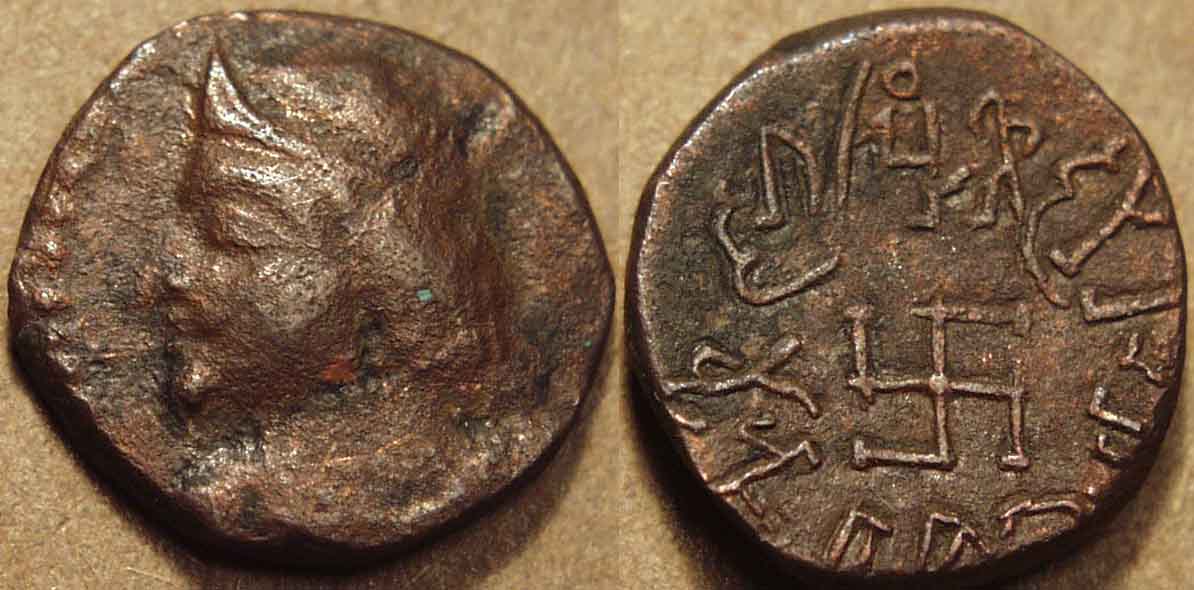
| Coin 18: Koziya, copper drachm (reduced weight standard)
c. 235-265 CE
Weight: 2.21 gm., Diam:14-15 mm.
Diademed, crowned bust left, dotted border /
Swastika right, Kharoshthi legend around:
(at 1h, counterclockwise) Koziyasa Kozanaputrasa Pāratarājasa
(Of Koziya son of Kozana, Pārata King) |
 |
Although Koziya was Kozana's son, it seems fairly clear that he did not follow his father to the throne but had to wait until the end of his "uncle" Bhimarjuna's reign. None of Koziya's coins show any trace of silver, plus his portrait is more different from Kozana's than Bhimarjuna's was. Finally, Koziya introduced a standing king type that was then copied by later rulers. |
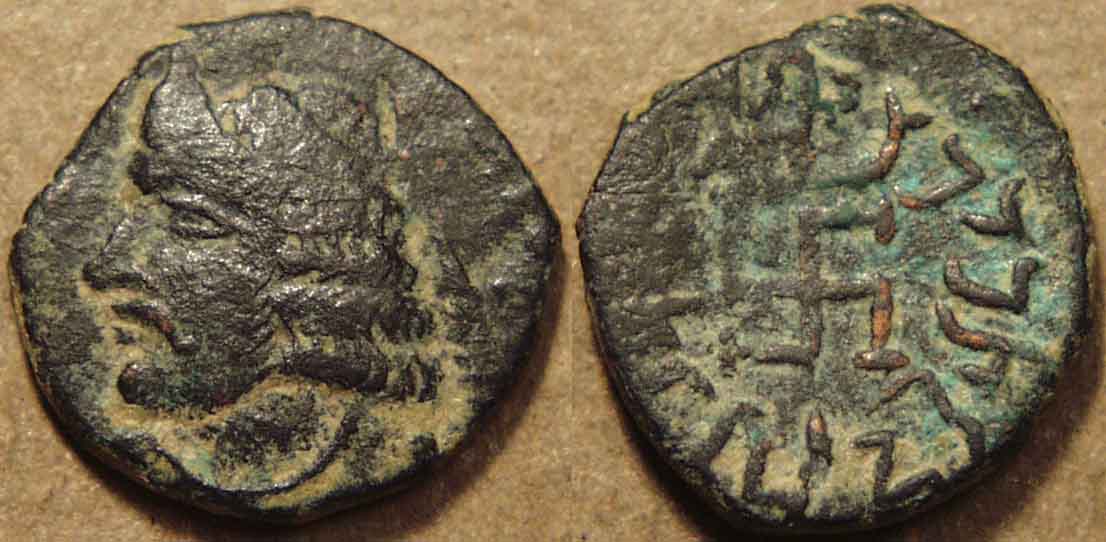
| Coin 19: Koziya, copper drachm (reduced weight standard)
c. 235-265 CE
Weight: 1.54 gm., Diam:12-14 mm.
Diademed, crowned bust left, dotted border /
Swastika right, Kharoshthi legend around:
(at 9h, counterclockwise) Koziyasa Kozanaputrasa Pāratarāja (no sa)
(Of Koziya son of Kozana, Pārata King) |
 |
Koziya issued several differnt types of copper drachms, some of very fine style, such as this one. Here, Koziya's portrait features a mustache for the first time. So Koziya must have risen to the throne as a teenager and probably had quite a long reign, given the wide variety of types he issued. |
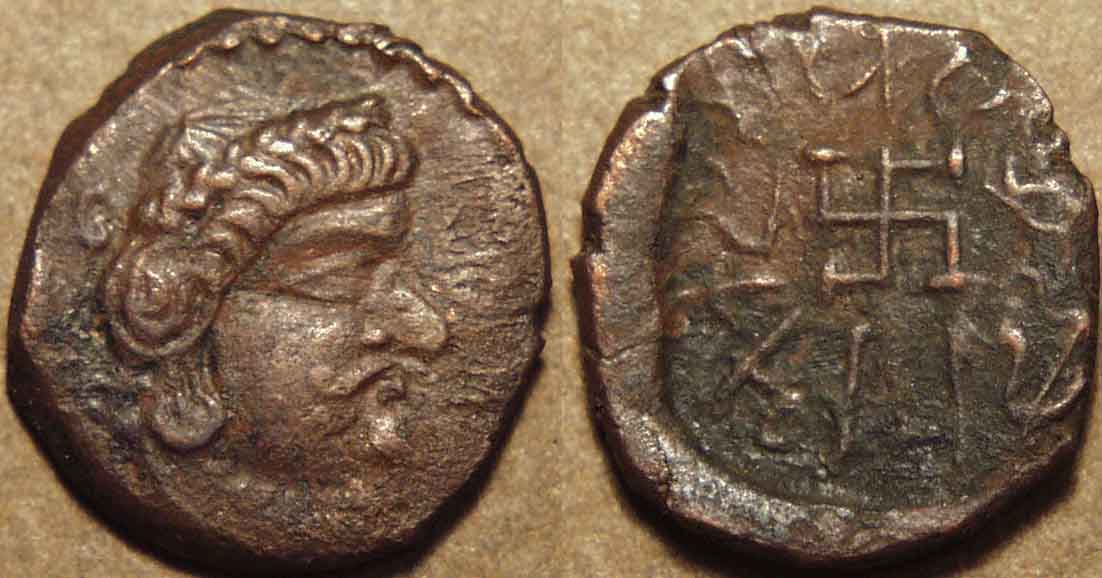
| Coin 20: Koziya, copper drachm (reduced weight standard)
c. 235-265 CE
Weight: 1.28 gm., Diam:12-13 mm.
Diademed bust right, wearing elaborate head-dress, dotted border /
Swastika right, Kharoshthi legend around:
(at 12h, counterclockwise) Koziyasa Kozanaputrasa Pāratarāja (no sa)
(Of Koziya son of Kozana, Pārata King) |
 |
Here Koziya issued a copper drachm with the bust facing right and wearing a new type of head-dress. |
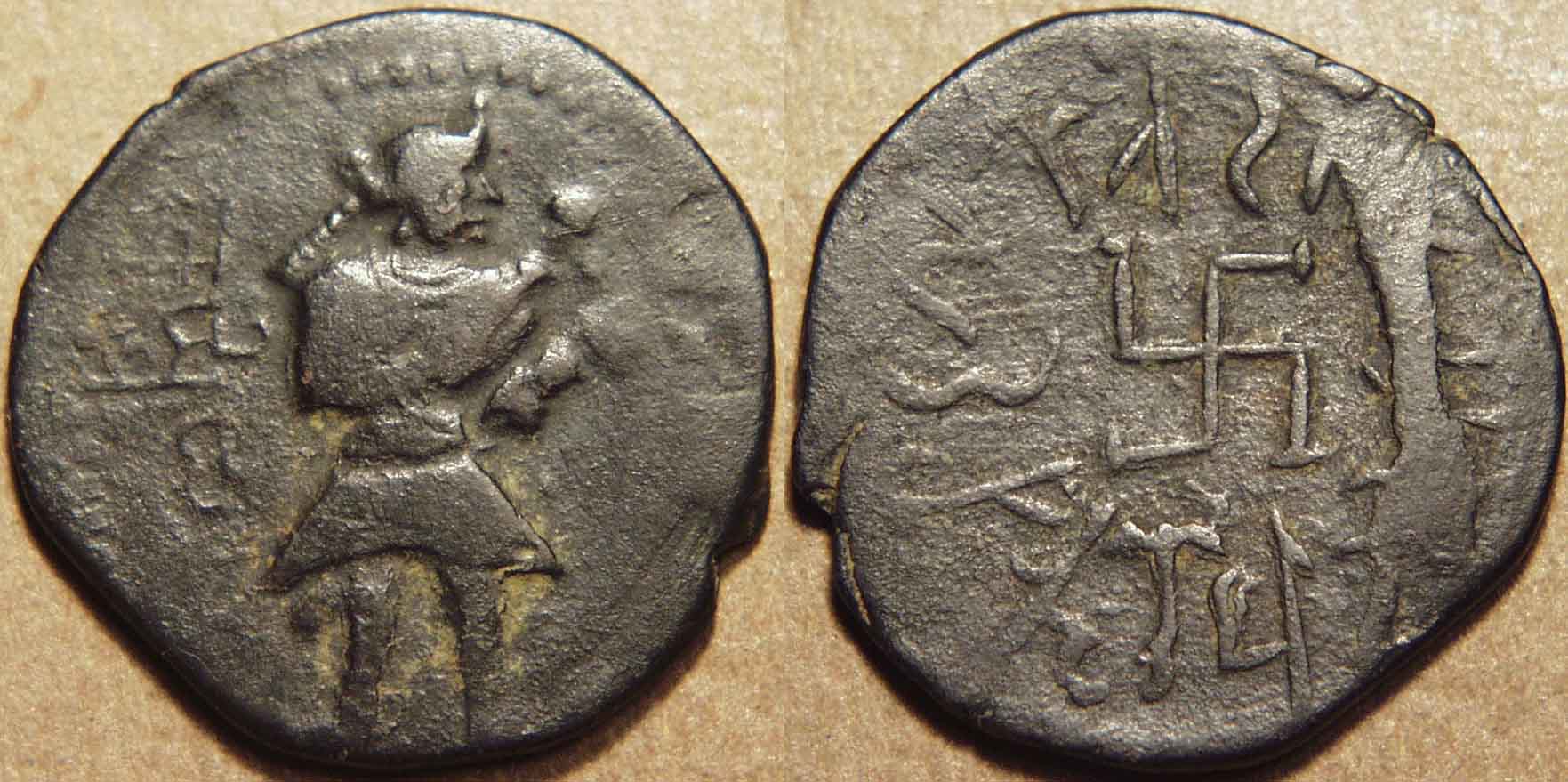
| Coin 21: Koziya, copper di-drachm
c. 235-265 CE
Weight: 3.87 gm., Diam: 20-21 mm.
King standing facing, head turned to right, Brāhmi legend at left: Koziya
Swastika turning right, Kharoshthi legend around (at 12 o'clock):
Koziyasa Kozanaputrasa Paratarajasa
(Of Koziya son of Kozana, Pārata King) |
 |
This seemingly insignificant copper coin has unlocked whole chapters of ancient Indian history! Because it has both a Brāhmi and a Kharoshthi legend, it served as a
sort of "Rosetta Stone" to unlock the name of this king: Koziya (previously read as Spajheya) and thereby helped to reorganize our understanding of the coinage of the
Pāratarājas. For more, see my 2009 paper. The coin is also helping re-write the
history of the Western Kshatrapas; for more on this, see the paper The Western Kshatrapa Dāmazāda, also forthcoming in the Numismatic Chronicle, 2009.
|
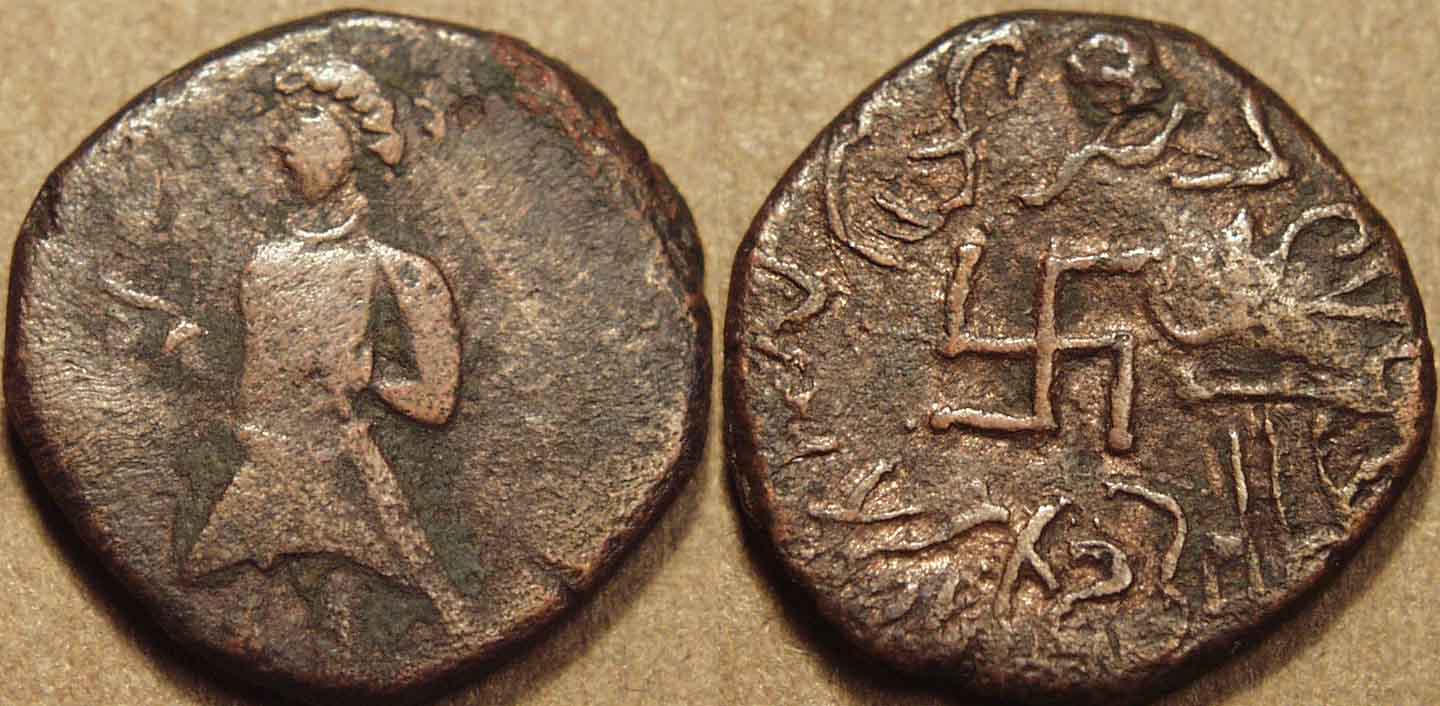
|
Coin 22: Datarvharna, copper di-drachm (reduced weight standard)
c. 265-280 CE
Weight: 3.40 gm., Diam:17-18 mm.
King standing facing, head turned to left/
Swastika right, Kharoshthi legend around:
(at 2h, counterclockwise) Datarvharnasa Datayolaputrasa Pāratarāja (no sa)
(Of Datarvharna, son of Datayola, Pārata King) |
 |
Datarvharna (pronounced Datarfarna) may have been Bhimarjuna's grandson. He issued no drachms as far as we know,
only these didrachms with the standing king. His coins can be distinguished by the fact that the king is facing left (Koziya's standing king faces right) and the swastika turns to the
right (the next coin, of Datarvharna's son Datayola has the swastika turning left). |
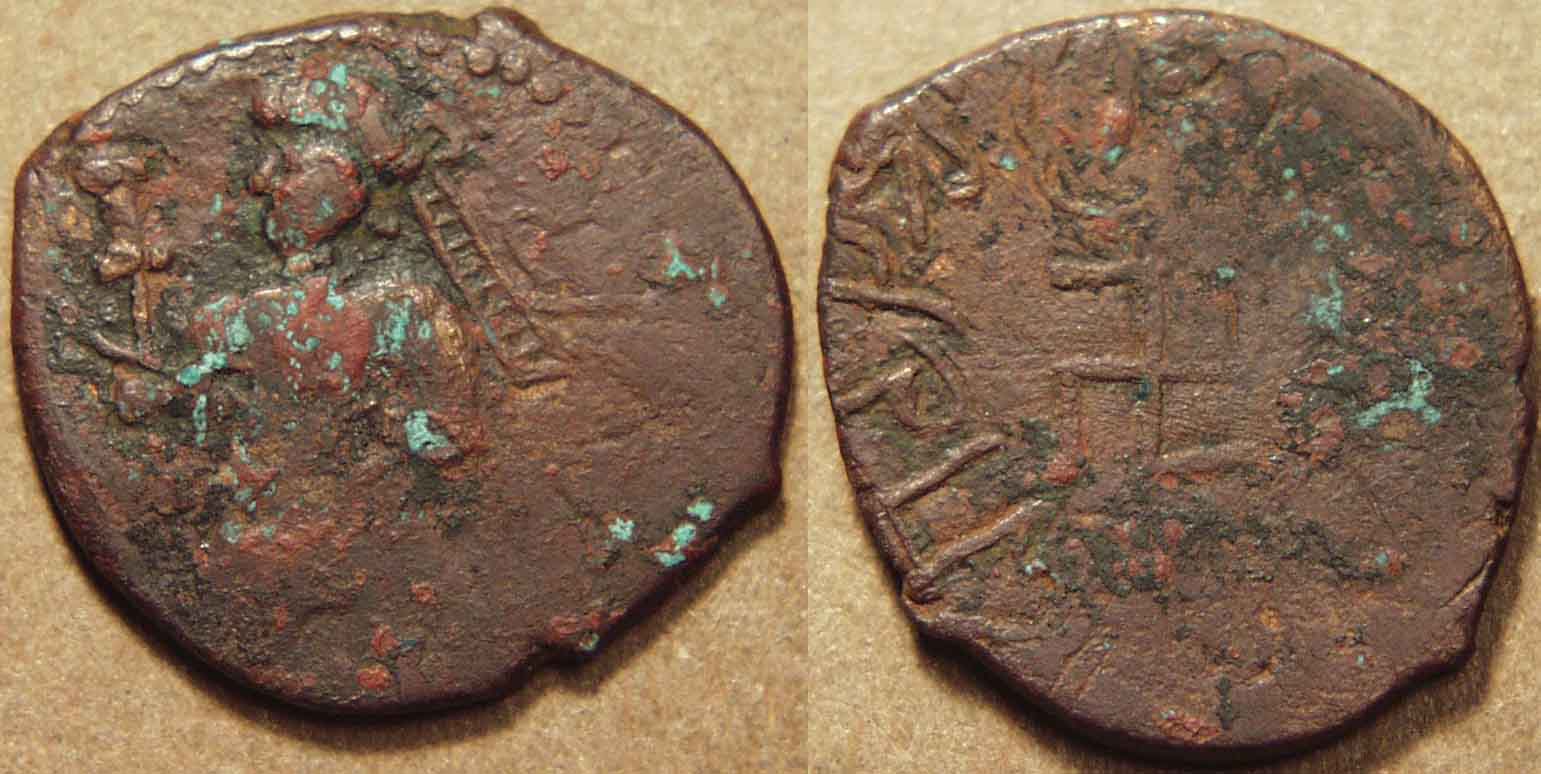
|
Coin 23: Datayola II, copper di-drachm (reduced weight standard)
c. 280-300 CE
Weight: 2.83 gm., Diam:17-19 mm.
King standing facing, head turned to left/
Swastika left, Kharoshthi legend around:
(at 6h, counterclockwise) Datayolasa Datarvharnaputrasa Pāratarājasa
(Of Datayola, son of Datarvharna, Pārata King) |
 |
Datayola must have been named for his grandfather. His coins can be distinguished by the fact that the king is facing left
and the swastika also turns to the left. Datayola's coins proved crucial to the proper dating of this dynasty. His coins have been found overstruck on coins of the Kushano-Sasanian
king Hormizd I, who is dated to 270-290. Thus Datayola II must have ruled somewhat contemporaneously or just after Hormizd. |
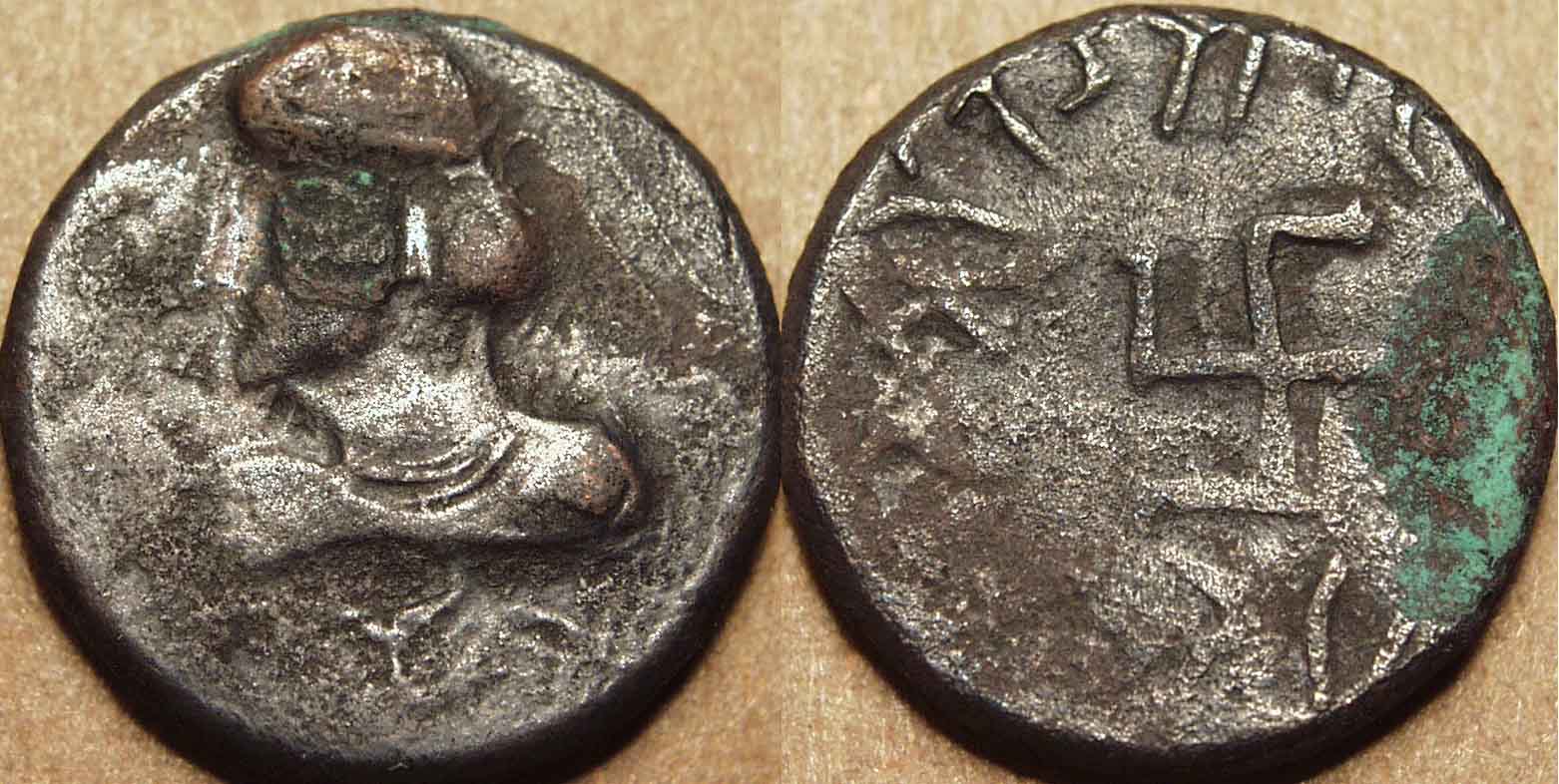
|
Coin 24: Datayola II, copper tetradrachm (reduced weight standard)
c. 280-300 CE
Weight: 7.72 gm., Diam: 20 mm.
Diademed bust of king left/
Swastika right, Kharoshthi legend around:
(counterclockwise) Datayolasa Datavharnaputrasa Pāratarājasa
(Of Datayola, son of Datarvharna, Pārata King) |
 |
Datayola issued this entirely new donomination - a tetradrachm. This is the heaviest Pāratarāja coin known.
|
|
|